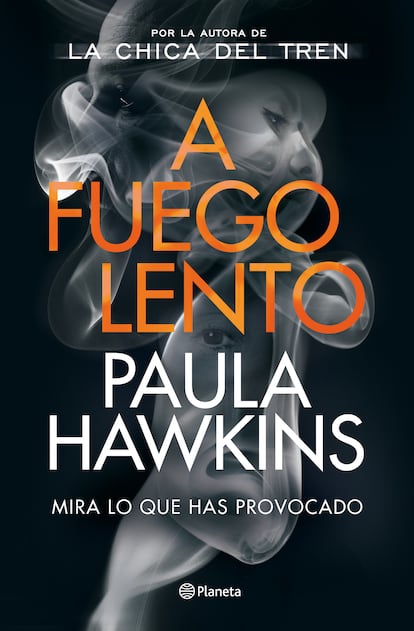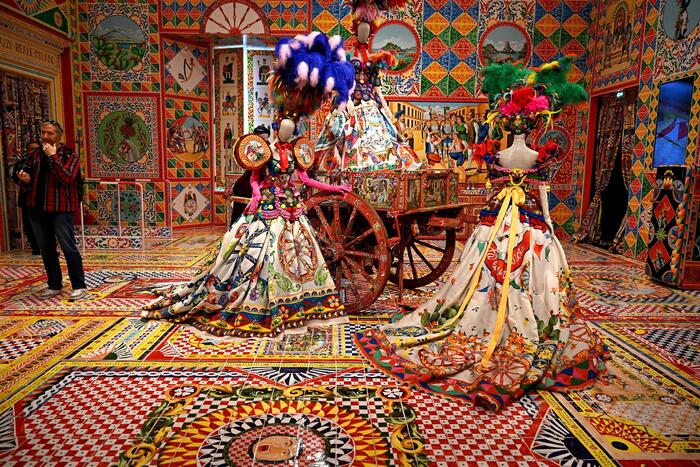EL PAÍS exclusively presents this text by the author of
La chica del tren
, with a translation by Aleix Montoto.
In it, Hawkins (Harare, Zimbabwe, 48 years old) sheds the germ of his new novel and reflects on the limits of artistic appropriation or how what he reads influences him.
Paula Hawkins, the paranoid girl who defeated Dan Brown
Like the two novels I wrote before
Slow Fire
, this one grew out of one character.
And, like those two previous novels, developing that character and finding the right story for him has not been an entirely straightforward process.
I started working on a new novel in the fall of 2017, after the promotional tour for
Escrito en el agua.
.
By March of the following year, I had rewritten the initial 30,000 words about three times and was still unconvinced, so I abandoned the novel.
Without being very clear about what to do next, I began to work on a story in which the chance encounter between a young woman whose life is in crisis and a much older woman who has recently lost her husband was narrated.
I never completed it either, but during the writing process I discovered two wonderful characters: Laura, a young woman who has suffered terrible setbacks in her life and who barely manages to cope with a chaotic existence, and Irene, a lonely old woman.
Over time, the friendship that was born from the chance encounter between these two characters would become one of the central elements of
A slow fire.
.
When I met these characters, I wasn't entirely sure what kind of story they would fit into, but I did know, nonetheless, that Laura had to play a pivotal role in whatever story she wrote next, whatever it was. Like Rachel from
The Girl on the Train
, a character I referred to only as La Borracha during the years when she existed solely in my imagination, I knew Laura was a character I wanted to explore more and — I imagined — would also be the type of character that readers would empathize with and want to follow and support.
Around Laura I built a network of characters, all of whom contest, in their own way, the idea that there are
good
and
bad people
.
Everyone has suffered in some way, everyone has had to face tragedies and losses.
Some have incorporated it into their lives, and the pain they feel is such a part of themselves that they are hardly aware of it.
In developing the story, one of the central themes that took shape was how our emotional burden (which may be due to tragedy or loss, but also to pride, guilt or even love) can harm us.
I don't know if it's just my thing, but when I walk around, I usually look for places that could be good options if you want to get rid of a corpse.
What I discovered was that my characters could take me in many different directions, a situation that is certainly exciting as a writer, but also overwhelming.
I had to find out how far each of these characters could go if the right opportunity presented itself.
Would Miriam, Laura or Carla be willing to lash out with anything to repair damage from the past?
From this starting point I began to build the plot of the novel, intentionally letting the characters that made up its cast collide in a way that was both traumatic and healing: a custom that, as a novelist, has become for me. at the same time on a theme and on a strategy.
Locations
The novel is set in London and the locations that appear are inspired by places near my house. In early 2018, when I started writing the novel, I used to spend many mornings strolling the Regent's Canal, people-watching and barge-watching. I don't know if it's just my thing, but when I walk, I usually look for places that could be good options if one wanted to get rid of a body, and then I noticed that, although most of the barges converted into houses that are in the canal They are wonderfully maintained and it is clear that they receive a lot of care, others seem to have been abandoned and there are even some partially submerged; And I also realized that, if someone were to hide a corpse in one of these, days or even weeks could pass without anyone discovering it ...
What happens in the novel is very different, of course, but it was always clear to me that there would be a corpse on a barge, and it seemed pertinent that the rest of the action took place in the streets and squares surrounding the canal in that area of London, whose history also turns out to be very rich and unique.
South of the canal is Clerkenwell, the area where Irene and Laura (and me!) Live.
It is the oldest residential and business district in the city, and in the past was home to several religious institutions, including a monastery of the Order of Saint John of Jerusalem and an Augustinian convent dedicated to Saint Mary.
Later, however, it developed a seedy reputation as an area frequented by thieves and poor women.
In the 19th century, it was considered the area with the highest murder rate in London.
Today, Clerkenwell is extremely gentrified, its streets filled with designer shops and some of the best restaurants in the city, yet it is still a place with a very heterogeneous population. It is one of the many areas of London where wealthy people live alongside others without as many resources, and where the privileged rub shoulders with those less fortunate on a daily basis. We live in a deeply unequal society that is becoming increasingly so: it is not difficult to imagine how infuriating this can be for people who find themselves in difficult circumstances and who feel powerless because they cannot change their destiny; people like Miriam or Laura.
The paradoxical loneliness in which many residents of this overcrowded area of central London live is also evident.
One afternoon my partner and I were returning home from a movie when, in the alley of Hayward's Place, we saw an old woman standing outside her front door.
He was looking from side to side with an uneasy expression on his face, as if he was looking for someone.
As we approached, the old woman asked my partner if she could go into her house and change a light bulb, which he did.
She thanked him and we continued on our way, but I was very impressed by the loneliness that the scene we had just experienced showed: the fact that a person had to wait patiently in the street until they found someone who could help them.
The pandemic
By the time the pandemic hit, he had already written and rewritten the novel more than once. Fortunately, he had finally found the right way to tell the story, he had solved most of the problems, and he also knew where all the turns would take place - all he had to do then was write it all down. The arrival of the confinement, then, was not exactly a blessing, but it was not a punishment either. Like everyone else, the situation made me uneasy and scared. In particular, I was worried about my family, who live thousands of miles away and who I didn't know when I could visit (and I still don't know). But since she was forced to stay at home, she couldn't travel or socialize, and I don't have children to teach, there was little I could do except write. Write, go for a walk or run, read, cook, watch television,write a little more ... and read.
Readings
Some writers try not to read works of fiction when they write.
In my case, I try not to read anything that bears any similarity to the work I am writing, and I usually avoid detective novels for fear that the plots of others will influence me, but I cannot not read.
Reading is a source of inspiration to me and a constant reminder of why I want to do this.
Reading the work of writers I admire is essential, especially when the writing process becomes difficult or daunting.
With that in mind, I have compiled a list of some of the books that I read (or reread) while writing
Slow Fire
.
Some of these titles, in fact, have ended up appearing in the novel itself ...
-
All My Puny Sorrows
(2014) and
They Talk
(2018; Sixth Floor, 2020), by Miriam Toews Sunburn (2018)
- By Laura Lippman
How it All Began
(2011), by Penelope
Lively Desoriental
(2016; Malpaso Ediciones, 2017),
- De Negar Djavadi
Everything Here Is Beautiful
(2018), by Mira T. Lee
The Curse of Hill House
(1959; Minuscule Editorial, 2019), by Shirley Jackson
Ghost Wall
(2018; Sixth Floor, 2020), by Sarah Moss
A Trial de piedra
(1977; Mundo Actual de Ediciones, 1982), by Ruth Rendell
The long river of souls
(2020; Alianza Editorial, 2020), by Liz Moore
La mala seed
(1954; Alianza Editorial, 2017), by William March
The Language of Birds
(2019), by Jill Dawson
Blow Your House Down
(1984), by Pat Barker
Endless Sky
(2019; Alianza Editorial, 2021), by Kate Atkinson
The postman always calls twice
(1934; RBA Bolsillo, 2021), by James M. Cain
The Diver's Clothes Lie Empty
(2015), by Vendela Vida
La dependent
(2016; Duomo Ediciones, 2019), by Sayaka Murata
En carne viva
( 1995; Ediciones B, 2000), by Susanna Moore
The Weekend
(2019), by Charlotte Wood
The Bass Rock
(2020), by Evie Wyld
The actress
(2020; Seix Barral, 2021), by Anne Enright
Ideas and influences
While I read a lot when I'm writing, I understand why other writers don't: they are afraid to adopt — even unwittingly — an idea, voice, or plot element from another book. In my case, when I read I want to be influenced by the works of Penelope Lively and Anne Enright, I want to be inspired by their words and their powerful intelligence, I want them to activate my mind in such a way that, when I sit down to write, I find myself in the most creative state possible.
What a writer can or has the right to take and transform into art is one of the central questions of
Slow Fire
.
I borrow things from my life and from those around me continuously: what happens to Laura as a child is a version — considerably altered — of something that happened to a friend of a friend of a friend;
As for what Miriam suffers, it is inspired by a story I read in a newspaper years ago.
What a writer can or has the right to take and transform into art is one of the central questions of A slow fire
Why do we have the right to take things from life but not from art?
Is that so?
Is there a limit?
I have a partial answer to that question, which, conveniently, I have borrowed from another writer.
In a recent article, Nicole Krauss wrote about the origin of many fictional characters: "Their corpses are dragged to our shores, no one knows where they came from or why they did it, and over the years we try to resurrect them" .
Whether it is resuscitation or transformation, what the writer must do is create something new.
Finals
And, after creating something new, you have to find a suitable ending for that creation. The beginning has always been the easiest and happiest part of writing for me. This is followed by a complicated middle section and then the always tricky ending: ending the story in a way that is genuine but not too bleak, and solving the mystery in a way that is both surprising and satisfying, as well as believable. There are other considerations as well: are the characters getting what they deserve? Should they do it? And, even more important, is the reader getting what he deserves?
What the writer owes the reader is another question too thorny to answer in a few hundred (or thousands) of words, but there are some ground rules that we can all agree on. If, for example, a reader begins to read a novel that has been sold to him as a romantic comedy, it is reasonable to expect that the protagonists do not die tragically at the end of the book. Sometimes a writer can get away with breaking that rule (I'm thinking of you, David Nicholls), but if he does, he must offer a very good reason for it and be able to show that the novel is much richer. and gratifying thanks to that transgression.
Likewise, in detective novels, the reader can count on, at the very least, ending up finding out who the culprit is. Let the mystery be solved. And, I would add, you should still hope that enough clues have been offered to you so that, if you pay proper attention, you can figure it out yourself. Now, in the case of detective novels, it is the same as with romantic comedies: there are exceptions (I am thinking of you now, Tana French). Also, while I think the main mystery needs to be solved, that doesn't mean that all the issues raised in the novel need to be solved as well. In fact, I prefer to leave some room for doubt and ambiguity and allow the reader to make their own speculations about it. We can't know the answer to all mysteriessome crimes are never solved and some villains are never punished. This is life.









/cloudfront-eu-central-1.images.arcpublishing.com/prisa/6LR4RYAGZZBYTPDW3Y4WG67SQI.jpg)